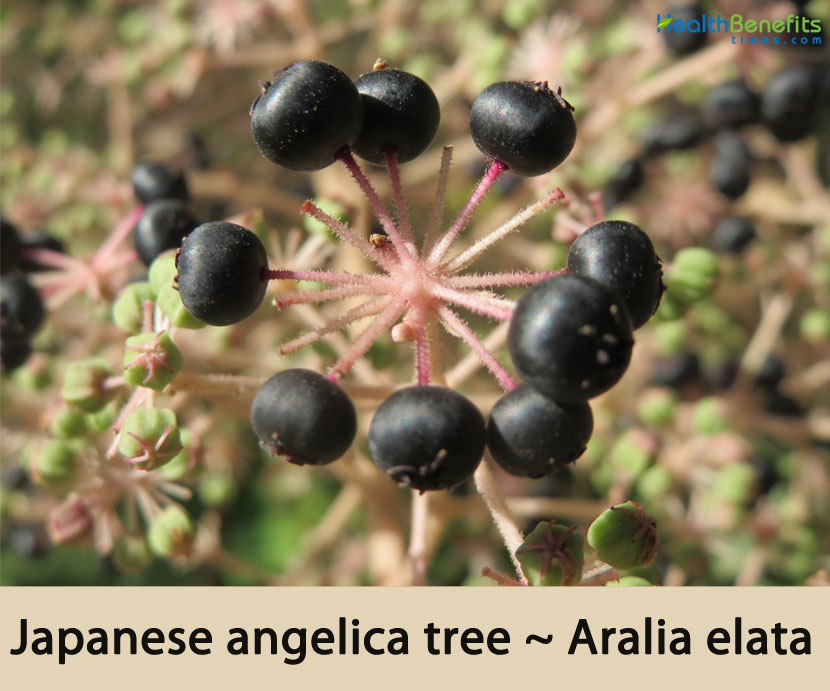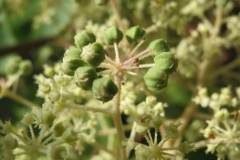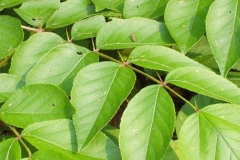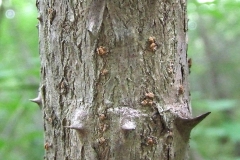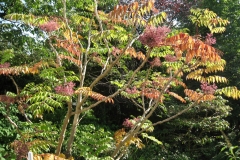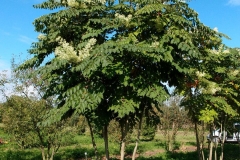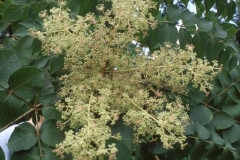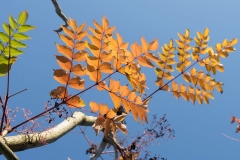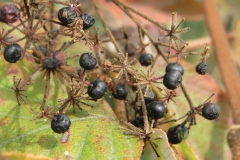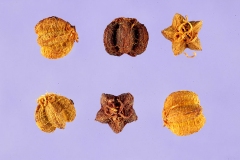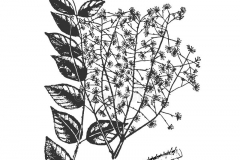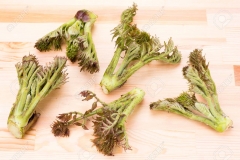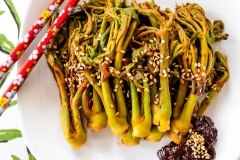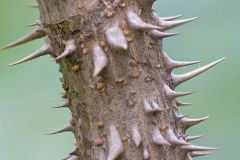| Japanese angelica tree Quick Facts | |
|---|---|
| Name: | Japanese angelica tree |
| Scientific Name: | Aralia elata |
| Origin | Eastern Russia, China, Korea, Japan and northern Asia |
| Colors | Initially green turning to purple to black as they mature |
| Shapes | Clusters of small, fleshy, globose to subglobose drupes (4 mm in diameter) |
| Health benefits | Support for rheumatoid arthralgia, coughs, diabetes, jaundice, stomach ulcers, stomach cancers, chronic fatigue, depression, diabetes, stress and anxiety |
| Name | Japanese angelica tree |
|---|---|
| Scientific Name | Aralia elata |
| Native | Eastern Russia, China, Korea, Japan and northern Asia |
| Common Names | Japanese angelica-tree, Japanese aralia, Dureumnamu, Dureupnamu, Turup, Turupnamu, Hercules-club, Chinese angelica-tree, Korean angelica-tree, Oni’s Walking Stick |
| Name in Other Languages | Arabic: Aralia ealia (أراليا عالية) Armenian: Aralia manjurakan (Արալիա մանջուրական) Azerbaijani: Hündür araliya Bulgarian: Visoka araliya (висока аралия) Chinese: Cong mu (楤木), Liao dong mu hu mu (辽东木忽木 ), Liao dong song mu (辽 东楤木) Czech: Arálie vysoká Danish: Fandens spadserestok, Havearalie, Have-aralie, Manchurisk Aralie Dutch: Duivelswandelstok, engelenboom English: Japanese angelica-tree, Japanese aralia, Chinese angelica-tree, Oni’s Walking Stick, Hercules’ club Estonian: Kuradipuu Finnish: Piikkiaralia, pirunkeppi French: Angélique en arbre du Japon, angélique de Chine, angélique du Japon, aralie japonaise, arbre angélique du Japon, L’Angélique du Japon, Aralie élevée German: Japanische Aralie, Japanischer Angelicabaum, Stachelaralie, Teufelskrückstock, Die Japanische Aralie, Hohe Aralie Hungarian: Mandzsu arália Italian: Aralia elevate, angelica del Giappone Japanese: Tara no ki (タラノキ), Japanischer Angelikabaum, Tara (タラ) Korean: Deu-reum-na-mu (드릅나무), Du reup na mu, Dureup, Turup Norwegian: Høstaralia Polish: Aralia wysoka, Aralia mandżurska, aralia japońska, dzięglawa japońska Portuguese: Arbol-de-angélica-japonesa Russian: Araliya man’chzhurskaya (Аралия манчжурская), Araliia vysokaia (Аралия высокая) Slovene: Mandžurska aralija Spanish: Arbol de angelica, Mandžurska aralija Swedish: Parkaralia, Kinesisk parkaralia Welsh: Aralia Japan, Araliâu Japan Western Frisian: Duvelswannelstôk |
| Plant Growth Habit | Stunning, exotic-looking, upright deciduous, multi-stemmed, ornamental shrub or small tree |
| Growing Climates | Thin disturbed woodland, thickets, old fields, hedgerows, forest, forest margins, shrub land, meadow, scrub fields, roadsides, hillside, stream sides, ravines, secondary forest and occasionally along open, sunny streams and rivers |
| Soil | Easily grown in average, medium moisture, well-drained soils in full sun to part shade. It prefers moist, fertile, humusy loams, but tolerates a wide range of soils including rocky and clayey ones |
| Plant Size | 20 to 40 feet and a width of 15 to 30 feet |
| Root | Plants form shallow roots |
| Stem | Coarse, thick stems have sharp prickles and prominent large leaf scars. The stems are covered in spines |
| Bark | Bark is grey and has a thorny surface |
| Leaf | Large, dark green, alternate leaves 70-125 cm long, 50-90 cm wide, with 3-5 pinnae and are bi- or tri-pinnately compound. Leaves are pubescent beneath, with veins running to the ends of the serrations. Petioles are pubescent or becoming nearly glabrescent, unarmed and greenish |
| Flowering season | Late summer (July through August) |
| Flower | Flowers are greenish white colored. Sepals are minute, triangular to round. Petals are ovate, 1.8-2.2 mm long. Filaments are 2-2.5 mm long; anthers are yellowish white, oblong, 0.7-1.2 mm long. Ovary is 5-locular; styles distinct. Floral disc is projected |
| Fruit Shape & Size | Clusters of small, fleshy, globose to subglobose drupes (4 mm in diameter) |
| Fruit Color | Initially green turning to purple to black as they mature |
| Propagation | By seed when ripe or root cuttings and suckers |
| Plant Parts Used | Roots, bark and flowers |
| Season | Appearing August to September and ripening from September to October |
| Other Facts |
|
Plant Description
Japanese angelica tree is a stunning, exotic-looking, upright, deciduous, multi-stemmed, ornamental shrub or small tree. The plant can be found in the wild, in eastern Asia, where it usually grows much larger, up to 20 to 40 feet tall and 15 to 30 feet wide, than is usually observed in home gardens where it more typically grows up to 20 feet tall and 10 feet wide. It is capable of growing at a rate of two feet in a single season. It has a spreading habit and can be multi or single stemmed. The plants form shallow roots. Coarse, thick stems have sharp prickles and prominent large leaf scars. The stems are covered in spines. Bark is grey and has a thorny surface. The plant is found growing in thin disturbed woodland, thickets, old fields, hedgerows, forest, forest margins, shrub land, meadow, scrub fields, roadsides, hillside, stream sides, ravines, secondary forest and occasionally along open, sunny streams and rivers. The plant easily grows in average, medium moisture, well-drained soils in full sun to part shade. It prefers moist, fertile, humus loams, but tolerates a wide range of soils including rocky and clayey ones. It can also tolerate drought. It can generally tolerate many urban pollutants.
Leaves
Large, dark green, alternate leaves 70-125 cm long, 50-90 cm wide, with 3-5 pinnae and are bi- or tri-pinnately compound. Leaves are pubescent beneath, with veins running to the ends of the serrations. Petioles are pubescent or becoming nearly glabrescent, unarmed and greenish. Leaves are arranged alternately and one leaf may contain as many 80+ ovate to elliptic leaflets (each to 3-4″ long). Leaflets are medium to dark green, ovate to broadly ovate, sometimes narrowly ovate to lanceolate, chartaceous, 6-15 cm long and 3.5-8.5 cm wide, acute to acuminate at apex, rounded to obtuse, occasionally sub cordate at base, serrulate to serrate, lateral veins 7-9 pairs, adaxial surfaces green, slightly rugose, sometimes scabrid, abaxial surfaces glaucous or brownish glaucous, pubescent to densely pubescent, sometimes pilose, pilose on veins, or glabrous, petiolules 0-6 mm long. In fall, leaves turn pale yellow to reddish purple and may drop early in season.
Flower
Small, 5-petaled, white flowers (to 1/8” across) bloom in large, terminal, umbellose panicles (25-55 cm long, 35-80 cm wide) in late summer (July through August). Floral buds are yellowish green. Flowers are quite showy and very attractive to bees. Flowers are greenish white colored. Sepals are minute, triangular to round. Petals are ovate, 1.8-2.2 mm long. Filaments are 2-2.5 mm long; anthers are yellowish white, oblong, 0.7-1.2 mm long. Ovary is 5-locular; styles distinct. Floral disc is projected. These flowers are wider than they are tall, radiate from separate stems within a cluster and lack a central axis.
Fruits
Fertile flowers are followed by clusters of small, fleshy, globose to subglobose drupes (4 mm in diameter) that ripen from late summer into fall. Fruits are initially green turning to purple to black colored berries. Fruits start appearing from August to September and ripening from September to October. Drupes are quite attractive to birds and distributed by wildlife. This invasive plant also suckers from its base and spreads.
Traditional uses and benefits of Japanese Angelica Tree
- The roots and stems are anodyne and carminative.
- All parts of the plant are used for the treatment of rheumatoid arthralgia, coughs, diabetes, jaundice, stomach ulcers and stomach cancers.
- It is a natural remedy for a number of mental and emotional conditions as it helps work on the nervous system.
- Aralia extracts and herbal teas can help address issues like chronic fatigue, depression, stress and anxiety.
- Aralia can also help boost mood, memory and overall vitality.
- It’s also used to alleviate headaches and to ease liver and urinary tract disease symptoms.
- Plant is used in traditional Chinese and Korean medicine for the treatment of several diseases, including diabetes.
- It is used in the treatment of diabetes and rheumatoid arthritis in traditional folk medicine in East Asia.
- The root, and especially the bark, stimulates the central nervous system.
- The plant is said to restore the appetite, memory, vigor etc.
Culinary Uses
- Young shoots can be consumed after cooked.
- They can also be blanched and used in salads.
- The young shoots of Aralia elata are a popular wild food in Japan where the tree is known as Taranoki and the shoots as Taranome.
- In Japan, the shoots are called tara-no-me and are eaten in the spring.
- They are picked from the end of the branches and are fried in a tempura batter.
Management Methods
Biological Control
There are currently no biological control agents in use against this species.
Manual or Mechanical Control
Pulling / Digging Up
Hand pulling or digging young plants is effective if performed prior to seed set. Larger individuals must be removed using a weed wrench; however, the species has a tendency to create root sprouts if a significant amount of material is left in the ground.
Mulching
Mulching may help reduce the seed bank and cover bare ground after infestations have been controlled via spraying and or pulling, however, this will also reduce the reestablishment of other, native vegetation in the area, too
Chemical Control
The pesticide application rates and usage herein are recommendations based on research and interviews with land managers. When considering the use of pesticides, it is your responsibility to fully understand the laws, regulations and best practices required to apply pesticides in a responsible manner. At times, the pest you seek to treat may not be on a pesticide label, requiring a 2ee exemption from NYSDEC. Always thoroughly read the label of any pesticide and consult the NYSDEC or a licensed pesticide applicator with questions.
References:
https://www.itis.gov/servlet/SingleRpt/SingleRpt?search_topic=TSN&search_value=184745#null
https://npgsweb.ars-grin.gov/gringlobal/taxon/taxonomydetail?id=3815
https://pfaf.org/User/Plant.aspx?LatinName=Aralia+elata
https://www.missouribotanicalgarden.org/PlantFinder/PlantFinderDetails.aspx?taxonid=276610
https://invasive-species.extension.org/aralia-elata-japanese-angelica-tree/
https://www.cabi.org/isc/datasheet/6977
https://plants.sc.egov.usda.gov/home/plantProfile?symbol=AREL8
http://www.theplantlist.org/tpl1.1/record/kew-14042
https://gd.eppo.int/taxon/ARLEL
https://en.wikipedia.org/wiki/Aralia_elata


